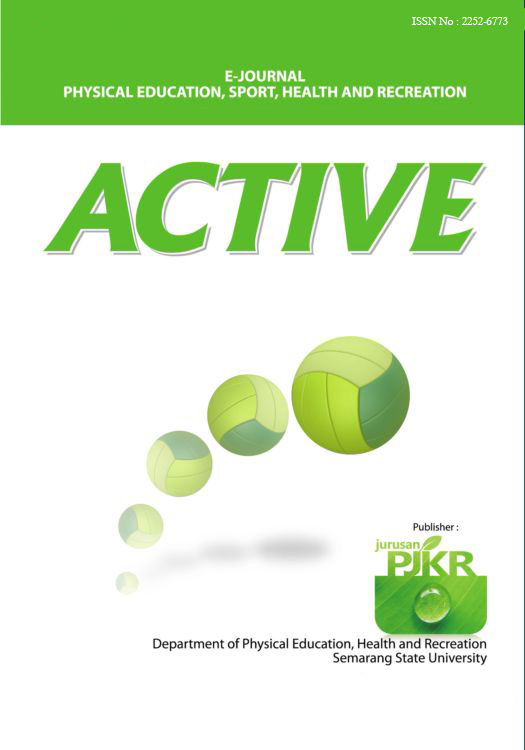PENINGKATAN PEMBELAJARAN GERAK DASAR ATLETIK DENGAN PERMAINAN POS BERANGKAI
Main Article Content
Abstract
The purpose of this study was to determine the presence or absence of an increase in learning basic athletic
motion with sequential post game at third grade students of SDN 01 Sidosari Kesesi Pekalongan 2014 This
study is a Class Action Research (Classrom Action Research), the results of studies using 2 cycles. Each cycle
begins with planning, action, observation / evaluation and reflection. As many as 24 students study subjects
consisted of 16 boys and 8 female student. Data collection is done by using the data field observations and
questionnaires obtained from the evaluation. In a study shows in the first cycle with the value of the percentage
of completeness 58% value is less satisfactory. Then resumed on the second cycle with a percentage value 92%
value produced in accordance with desired. From the research that has been done can be seen that the post
game sequential increase capacity and student learning outcomes in basic athletic motion at third grade
students of SDN 01 Sidosari. Improved athletic student learning basic movement using the postal game
sequential mastery shown by the percentage value of greater that 92%.
motion with sequential post game at third grade students of SDN 01 Sidosari Kesesi Pekalongan 2014 This
study is a Class Action Research (Classrom Action Research), the results of studies using 2 cycles. Each cycle
begins with planning, action, observation / evaluation and reflection. As many as 24 students study subjects
consisted of 16 boys and 8 female student. Data collection is done by using the data field observations and
questionnaires obtained from the evaluation. In a study shows in the first cycle with the value of the percentage
of completeness 58% value is less satisfactory. Then resumed on the second cycle with a percentage value 92%
value produced in accordance with desired. From the research that has been done can be seen that the post
game sequential increase capacity and student learning outcomes in basic athletic motion at third grade
students of SDN 01 Sidosari. Improved athletic student learning basic movement using the postal game
sequential mastery shown by the percentage value of greater that 92%.
Article Details
Section
Articles
References
Agus Kristiyanto, 2010. Penelitian Tindakan Kelas
(PTK) Dalam Pendidikan Jasmani &
Kepelatihan Olahraga. Surakarta: UNS Press.
Arma Adullah, 1994. Dasar-Dasar Pendidikan
Jasmani. Jakarta: PMTK
Bahagia Y. (2012). Pengembangan Media
Pengajaran Penjaskes. Direktorat Pendidikan
Luar Biasa.
Depdiknas, 2004. Kurikulum Tingkat Satuan
Pendidikan. Jakarta:Depdiknas.
Decaprio, R. (2013). Aplikasi Teori Pembelajaran
Motorik Di Sekolah. Jakarta: Rajawali Pers.
Rahyubi, H. (2012). Teori-Teori Belajar Dan
Aplikasi Pembelajaran Motorik: Deskripsi
dan Tinjauan Kritis. Majalengka: Referens.
Rusli, Lutan. 2001. Asas – asas Pendidikan Jasmani.
Bandung: FPOK UPI.
Sudjana. 2005. Metoda Statistika. Bandung: Tarsito
Sugihartono, 2007. Psikologi Pendidikan.
Yogyakarta: UNY Pres
Sukintaka. 1992. Teori Bermain Penjaskes. Jakarta:
Depdikbud, Dirjen Dikti.
Sukintaka. 2004. Teori Pendidikan Jasmani. Filosofi
Pembelajaran & Masa Depan. Bandung:
Nuansa.
Syarifuddin.A. dan Muhadi (1992). Pendidikan
Jasmani dan Kesehatan. Jakarta: Depdikbud.
Waryati. S. 1993. Pendidikan Permainan
Kecil . Jakarta : Departemen Pendidikan dan
Kebudayaan. Penerbit Universitas Terbuka.
Wahyuni, T. (2013). Mengenal Karakteristik anak
SD.
http://twahyu.student.fkip.uns.ac.id/2011/09
/30/ pada tanggal 24 Maret 2014
Wasty Sumanto, 1998. Psikologi Pendidikan. Jakarta:
PT Rineka Cipta.
www. Psikologi Bermain Anak. com/ Index. Php
www.kamusbahasaindonesia.org
Pedoman Penyusunan Skripsi, FIK Unnes Tahun
2014
(PTK) Dalam Pendidikan Jasmani &
Kepelatihan Olahraga. Surakarta: UNS Press.
Arma Adullah, 1994. Dasar-Dasar Pendidikan
Jasmani. Jakarta: PMTK
Bahagia Y. (2012). Pengembangan Media
Pengajaran Penjaskes. Direktorat Pendidikan
Luar Biasa.
Depdiknas, 2004. Kurikulum Tingkat Satuan
Pendidikan. Jakarta:Depdiknas.
Decaprio, R. (2013). Aplikasi Teori Pembelajaran
Motorik Di Sekolah. Jakarta: Rajawali Pers.
Rahyubi, H. (2012). Teori-Teori Belajar Dan
Aplikasi Pembelajaran Motorik: Deskripsi
dan Tinjauan Kritis. Majalengka: Referens.
Rusli, Lutan. 2001. Asas – asas Pendidikan Jasmani.
Bandung: FPOK UPI.
Sudjana. 2005. Metoda Statistika. Bandung: Tarsito
Sugihartono, 2007. Psikologi Pendidikan.
Yogyakarta: UNY Pres
Sukintaka. 1992. Teori Bermain Penjaskes. Jakarta:
Depdikbud, Dirjen Dikti.
Sukintaka. 2004. Teori Pendidikan Jasmani. Filosofi
Pembelajaran & Masa Depan. Bandung:
Nuansa.
Syarifuddin.A. dan Muhadi (1992). Pendidikan
Jasmani dan Kesehatan. Jakarta: Depdikbud.
Waryati. S. 1993. Pendidikan Permainan
Kecil . Jakarta : Departemen Pendidikan dan
Kebudayaan. Penerbit Universitas Terbuka.
Wahyuni, T. (2013). Mengenal Karakteristik anak
SD.
http://twahyu.student.fkip.uns.ac.id/2011/09
/30/ pada tanggal 24 Maret 2014
Wasty Sumanto, 1998. Psikologi Pendidikan. Jakarta:
PT Rineka Cipta.
www. Psikologi Bermain Anak. com/ Index. Php
www.kamusbahasaindonesia.org
Pedoman Penyusunan Skripsi, FIK Unnes Tahun
2014
